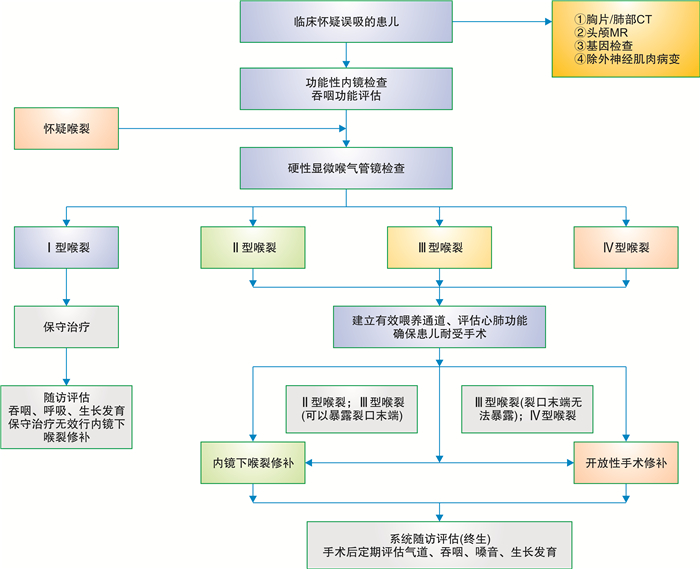Consensus recommendations on the evaluation and treatment of congenital laryngeal clefts
-
摘要: 先天性喉裂是一个罕见的气道畸形,主要表现为呛咳、喂养困难等,影响患儿的生长发育;严重的喉裂可以表现为严重的呛咳误吸,导致阵发性青紫,甚至死亡。随着内镜技术的发展,使得喉裂可以被早期发现和诊断。不同类型的喉裂治疗方案差异较大,早期的诊断与评估对于儿童耳鼻喉科医生至关重要。中国医师协会儿科医师分会儿童耳鼻咽喉专业委员会联合全国多家儿童医疗中心讨论拟定诊治共识,从症状学、客观检查等方面给出喉裂的诊断治疗方案,为临床规范化诊疗提供指导性意见。Abstract: Congenital laryngeal cleft is a rare airway malformation, mainly manifested as choking, feeding difficulties, which affects the growth and development of children. Patients with a severe laryngeal cleft may have recurrent aspiration, leading to cyanotic spells, or even death. Advances in development of endoscopic techniques have made early diagnosis possible. Depending on the degree of cleft, management may involve a variety of approaches ranging from medical management alone to open repair. Therefore, it is important for pediatric ENT doctors to diagnose and evaluate in clinical practice. This consensus statement, developed by the Pediatric otorhinolaryngology Professional Committee of the Pediatrician Branch of the Chinese Medical Doctor Association, provides comprehensive recommendations and standardized guidance on diagnosis and management of laryngeal cleft, based on symptomatology, physical examinations, and laboratory tests.
-
Key words:
- children /
- laryngotracheoesophageal cleft /
- diagnosis /
- treatment /
- evaluation /
- consensus
-

-
[1] Benjamin B, Inglis A. Minor congenital laryngeal clefts: diagnosis and classification[J]. Ann Otol Rhinol Laryngol, 1989, 98(6): 417-420. doi: 10.1177/000348948909800603
[2] Johnston DR, Watters K, Ferrari LR, et al. Laryngeal cleft: evaluation and management[J]. Int J Pediatr Otorhinolaryngol, 2014, 78(6): 905-911. doi: 10.1016/j.ijporl.2014.03.015
[3] Suterwala MS, Reynolds J, Carroll S, et al. Using fiberoptic endoscopic evaluation of swallowing to detect laryngeal penetration and aspiration in infants in the neonatal intensive care unit[J]. J Perinatol, 2017, 37(4): 404-408. doi: 10.1038/jp.2016.239
[4] 李辉, 季成叶, 宗心南, 等. 中国0~18岁儿童、青少年身高、体重的标准化生长曲线[J]. 中华儿科杂志, 2009, 47(7): 487-492. doi: 10.3760/cma.j.issn.0578-1310.2009.07.003
[5] Walker RD, Irace AL, Kenna MA, et al. Neurologic Evaluation in Children With Laryngeal Cleft[J]. JAMA Otolaryngol Head Neck Surg, 2017, 143(7): 651-655. doi: 10.1001/jamaoto.2016.4735
[6] Velayutham P, Irace AL, Kawai K, et al. Silent aspiration: Who is at risk?[J]. Laryngoscope, 2018, 128(8): 1952-1957. doi: 10.1002/lary.27070
[7] Londahl M, Irace AL, Kawai K, et al. Prevalence of Laryngeal Cleft in Pediatric Patients With Esophageal Atresia[J]. JAMA Otolaryngol Head Neck Surg, 2018, 144(2): 164-168. doi: 10.1001/jamaoto.2017.2682
[8] Kawaguchi AL, Donahoe PK, Ryan DP. Management and long-term follow-up of patients with types Ⅲ and Ⅳ laryngotracheoesophageal clefts[J]. J Pediatr Surg, 2005, 40(1): 158-164. doi: 10.1016/j.jpedsurg.2004.09.041
[9] Yeung JC, Balakrishnan K, Cheng ATL, et al. International Pediatric Otolaryngology Group: Consensus guidelines on the diagnosis and management of type Ⅰ laryngeal clefts[J]. Int J Pediatr Otorhinolaryngol, 2017, 101: 51-56. doi: 10.1016/j.ijporl.2017.07.016
[10] 陈超, 谭乐恬, 许政敏, 等. 儿童先天性喉裂评估方法与疗效分析[J]. 中华耳鼻咽喉头颈外科杂志, 2018, 53(1): 9-15.
[11] 谭乐恬, 陈超, 李琪, 等. 婴幼儿声门下狭窄合并喉裂的处理及临床分析[J]. 中国眼耳鼻喉科杂志, 2021, 21(2): 99-102, 105. https://www.cnki.com.cn/Article/CJFDTOTAL-YRBH202102006.htm
[12] 谭乐恬, 李琪, 倪祎华, 等. 颈前正中径路软骨支架重建环状软骨板修补Ⅲ型喉裂的效果分析[J]. 中华耳鼻咽喉头颈外科杂志, 2022, 57(9): 1110-1115.
[13] 中国医师协会儿科医师分会儿童耳鼻咽喉专业委员会, 婴幼儿喉气道结构异常评估的专家共识[J]. 临床耳鼻咽喉头颈外科杂志, 2023, 37(6): 403-408. https://lceh.whuhzzs.com/article/doi/10.13201/j.issn.2096-7993.2023.06.001
[14] Timashpolsky A, Schild SD, Ballard DP, et al. Management of Type 1 Laryngeal Clefts: A Systematic Review and Meta-analysis[J]. Otolaryngol Head Neck Surg, 2021, 164(3): 489-500. doi: 10.1177/0194599820947742
[15] Propst EJ. Repair of short type Ⅳ laryngotracheoesophageal cleft using long, tapered, engaging graft without need for tracheotomy[J]. Laryngoscope, 2016, 126(4): 1006-1008. doi: 10.1002/lary.25472
-





 下载:
下载: